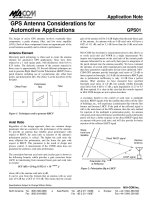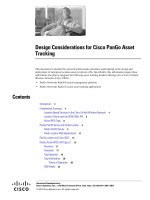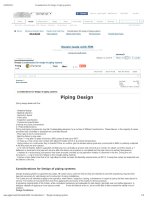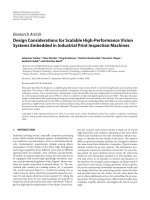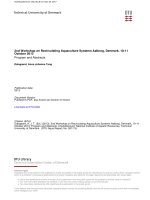Total gas saturation considerations for recirculating aquatic systems
Bạn đang xem bản rút gọn của tài liệu. Xem và tải ngay bản đầy đủ của tài liệu tại đây (1.87 MB, 10 trang )
Total Gas Saturation Considerations for Recirculating
Aquatic Systems
G. Rogers
Aquatic Ecosystems, Inc.
2395 Apopka Blvd.
Apopka, FL 32703 USA
Keywords: Zebrafish, Danio rerio, recirculating systems, water quality,
total gas pressure, total gas supersaturation
ABSTRACT
Zebrafish (Danio rerio) are now widely used in aquatic research facilities
for genetic and vertebrate development studies. Most of these facilities
utilize recirculating systems for zebrafish production. Dependable
production of high-quality fish is of vital concern in these recirculation
systems as these fish are valuable and in many cases irreplaceable in
terms of their significance to the research being conducted.
Water quality is of utmost concern in zebrafish systems. One critical
parameter that has received attention in these facilities is that of total gas
pressure. Under abnormal conditions, the partial pressures of dissolved
gases in the water can be greater than saturation. When this is the case,
there is a potential for problems with gas bubble trauma and an increasing
chance for secondary microbial infections. This paper discusses total gas
supersaturation theory, problems associated with supersaturation, methods
of monitoring total gas pressure, and ways that gas bubble problems can
be prevented in recirculating aquatic systems.
INTRODUCTION
Gas Transfer
Under steady-state conditions, the partial pressures of dissolved gases
in water are in balance with the pressures of the same gases in the
International Journal ofRecirculating Aquaculture 6 (2005) 39-48. All Rights Reserved
© Copyright 2005 by Virginia Tech and Virginia Sea Grant, Blacksburg, VA USA
International Journal of Recirculating Aquaculture, Volume 6, June 2005
39
Total Gas Saturation for Recirculating Aquatic Systems
atmosphere above the water. Henry's law (Equation 1) is used to
determine saturation concentrations of dissolved gases (Colt 1984).
C = 1000 KB X ((pATM - pH20)/760)
(1)
Where: C = Concentration of the gas (mg/L)
K = Ratio molecular wt of gas to volume (mg/mL)
B =Bunsen coefficient for the gas
pH20 = Vapor pressure of water (mm Hg)
pATM = Barometric pressure (mm Hg)
X = Mole fraction of the gas
According to Henry's Law, when the pressure of gas over the water
is decreased, the amount of dissolved gas also decreases. In addition,
the saturation concentrations of those gases will vary depending on
temperature, salinity, and pressure. Higher pressure increases the amount
of gas dissolved per unit volume, so the saturation concentration for a gas
will be higher in deeper water. The inverse is the case for temperature and
salinity. Water at higher temperature or salinity will have less gas per unit
volume. Table 1 and Figure 1 present saturation concentrations for various
gases in water at different temperatures.
Table 1. Sea level saturation concentrations ofdissolved gases and water
vapor pressure in freshwater at different temperatures (Colt 1984).
Temp
(C)
0
5
10
15
40
N2
(mg/L)
02
(mg/L)
Ar
(mg/L)
C02
(mg/L)
pH20
(mmHg)
23.0
20.3
18.1
14.6
12.8
0.89
0.78
0.69
1.09
0.89
4.6
0.75
6.5
9.2
0.62
0.63
12.8
0.56
0.51
0.54
0.46
17.5
23.7
0.46
0.42
0.39
0.40
0.35
0.31
31.8
42.2
16.4
11.3
10.1
20
25
14.9
13.6
9.1
30
35
12.6
11.7
7.5
6.9
40
10.9
6.4
8.2
International Journal of Recirculating Aquaculture, Volume 6, June 2005
55.3
Total Gas Saturation for Recirculating Aquatic Systems
Figure 1. Sea level saturation concentrations ofdissolved gases and water vapor pressure in
freshwater at different temperatures (Colt 1984).
-
.,, ti)
cl:
50.0 . . . . . . - - - - - - - - - - - - -
•
V.P. (mmHg)
......-----------+--
•
co2 (mg/L)
.§.
~
30.0 +--------____,.~--
--fr-N 2 (mg/L)
8~ ~f
20.0 -t----L.)""""""-:-------7'~----
--(}-02 (mg/L)
;
~
........
ti> GI
. :::
"'
0 0D..
C> ~
40.0
10.0 +---~""O""=:~--=----'=''-='--'
0
10
20
30
Temperature (C)
)(
Ar (mg/L)
40
The sum of the partial pressures of all dissolved gases plus the vapor
pressure of water is referred to as the Total Gas Pressure (TGP). The
difference between TGP and atmospheric pressure is defined as Delta
P (AP). Both TGP and AP are usually reported in mm Hg (millimeters
of mercury). TGP may also be reported as a percent of sea level or local
atmospheric pressure (TGP%). The following equations (Colt 1984)
present these relationships:
(2)
(3)
TGP =AP+ pATM
(4)
TGP% = (AP + pATM/ pATM) x 100
(5)
AP = (TGP% x pATM) 100 - pATM
(6)
International Journal of Recirculating Aquaculture, Volume 6, June 2005
41
Total Gas Saturation for Recirculating Aquatic Systems
Where: TGP =sum of the partial pressures of all dissolved gases and the
vapor pressure of water (mm Hg)
~p
=difference between TGP and atmospheric pressure (mm Hg)
TGP% = TGP as percent of atmospheric pressure (mm Hg)
pN2 = partial pressure of dissolved nitrogen (mm Hg)
p02 = partial pressure of dissolved oxygen (mm Hg)
pC02 = partial pressure of carbon dioxide (mm Hg)
=vapor pressure of water (mm Hg)
pAtm =atmospheric pressure (mm Hg)
pH20
Standard Methods for the Examination of Water and Wastewater (APHA/
AWWA/WEF 1992) recommends reporting values of ~p rather than TGP%
(percent saturation). However, percent of saturation has been widely used
in the past and is probably the most familiar method of reporting total
gas pressure data. The problem with the old data is that it was reported in
terms of TGP% without the corresponding barometric pressure data. As a
result it cannot be accurately converted to ~p values. Figure 2 presents the
relationship between ~p and TGP% for different elevations.
Figure 2. Relationship between !!J' and TGP% at different elevations.
-+--2000m
115
--.-1soom
~
a.
C>
I-
---l::r- 1000 m
110
--0-SOOm
105
---*-Sea Level
100-trm-------+-------+-------+----------I
0
25
so
75
100
Delta P (mm Hg)
42
International Journal of Recirculating Aquaculture, Volume 6, June 2005
Total Gas Saturation for Recirculating Aquatic Systems
Measurement of Dissolved Gases
Dissolved gases have been measured using manometry, volumetric tests,
mass spectrometry, gas chromatography, chemical titration, direct sensing
of pressure, and by headspace partial pressures (Tanner et al. 2003;
Watten et al. 2004). The latter method is the most common means of
total dissolved gas measurement and is completed using a saturometer or
tensionometer. These devices use a gas permeable membrane (silicone
rubber tube) that isolates the dissolved gases and water vapor from the
surrounding water. The membrane is connected to a manometer or
pressure transducer for pressure measurement.
These instruments measure either AP or TGP. When a manometer is used,
AP (difference between TGP and barometric pressure) is recorded. If a
pressure transducer calibrated to absolute pressure is used, then TGP is
reported. In this case, AP may be calculated using the local barometric
pressure. Other instruments utilize a pressure transducer set to zero at the
local barometric pressure. The AP is reported at that barometric pressure.
These devices must be corrected for changes in local barometric pressure.
The actual AP experienced by aquatic animals is the difference between
TGP and local pressure (barometric pressure plus the hydrostatic
pressure). This would be the pressure inside and outside the fish. Gas
bubbles will form only when the TGP is greater than the sum of the
compensating pressures (APHA/AWWA/WEF 1992; Colt 1984). The
compensating pressure is the hydrostatic water pressure, the barometric
pressure, and the pressure in the blood or tissues. Gas bubble trauma or
gas bubble disease can result if the TDGuncomp is greater than 100% or
if the AP uncomp is greater than zero (see Equations 7 and 8). The depth of
water where the AP uncomp is equal to zero is referred to as the hydrostatic
compensation depth. Below this depth, it is not possible for dissolved
gases to form bubbles or for bubbles to come out of solution. Above this
depth, bubbles may form both in the water column and in the blood and
tissues of aquatic organisms (Colt 1984).
APuncomp =AP - pgZ
TGP uncomp = [(pAtm + AP)/(pAtm + pgZ)] x 100
(7)
(8)
Where: AP uncomp =uncompensated AP (mm Hg)
TGP uncomp = uncompensated total gas pressure (mm Hg)
International Journal of Recirculating Aquaculture, Volume 6, June 2005
43
Total Gas Saturation for Recirculating Aquatic Systems
p = the density of water (kg/m3)
g =acceleration of gravity (9.8066 m/s 2)
Z =depth (m)
Before bubble growth can begin, a threshold L\P must be exceeded.
Thus, the t\P is a direct indicator of the potential for aquatic and marine
organisms to develop signs of gas bubble disease.
Causes of Gas Supersaturation
Numerous sources of gas supersaturation have been reported in the
literature. Some of these include; 1) spill from dams, 2) power generation
cooling water effluent, 3) solar heating, 4) geothermal heating, 5)
photosynthesis, 6) groundwater, 7) airlift aeration and gas injection
systems, 8) waterfalls, 9) pumping systems, 10) ice formation, 11)
barometric pressure changes, 12) aircraft transport, and 13) ocean waves.
For additional information on each of these processes, see the publication
by Fidler and Miller (1994).
Gas supersaturation seldom develops in recirculating zebrafish growout
systems. However, when it has occurred, there have been two primary
causes. The first cause is the rapid heating of water that is under pressure.
This can occur in systems utilizing temperature-mixing valves. Because
gas solubility decreases as the temperature rises, cold supersaturated
water can release bubbles as it is warmed (due to the reduced capacity of
the warm water to hold dissolved gas). This may be the case when cold tap
water (pressurized to about 50 psi) in piping is depressurized to the local
atmospheric pressure. A good practice would be to always degas source
water prior to use, especially if it has been heated by more than 5° C (10°
F).
The other cause of supersaturation in recirculating aquatic systems can
be the result of air drawn into a water pump. Within the pump, the air is
forced into solution under high pressure resulting in supersaturation. This
may be the case if there is an air leak in the piping on the suction side of
the pump, if air is introduced in a sump near the pump inlet, or if a vortex
forms in the sump or tank near the pump inlet. Air bubbles introduced
into the inlet of the pump by one of these methods may result in total
dissolved gas supersaturation levels as high as 110% in less than 5 minutes
(unpublished data). Thus, it is very important to routinely ensure that none
of the following conditions are occurring: air leaks in suction piping, low
44
International Journal of Recirculating Aquaculture, Volume 6, June 2005
Total Gas Saturation for Recirculating Aquatic Systems
water levels causing a vortex in sumps, and the introduction of air bubbles
near the suction inlet of the pump.
Problems Associated with Gas Supersaturation
Dissolved gas supersaturation has been shown to result in several
problems for aquatic animals. Some of these conditions include; 1) bubble
formation in the cardiovascular system, 2) over-inflation and/or rupture
of the swim bladder, 3) bubble formation in the gills, 4) blistering in the
skin particularly around the eyes, 5) bubbles in internal organs, 6) loss of
swimming ability, 7) susceptibility to secondary infections, and 8) altered
blood chemistry (Weitkamp and Katz 1980, Colt 1986, Fidler and Miller
1994, Speare 1998).
Figure 3. Macroscopic gas
bubbles in the tissues around
eyes of zebrajish exposed to
gas supersaturated water
(signs ofexophthalmia or
"pop-eyed" appearance).
(Photo courtesy ofJennifer
L. Matthews, D. V.M. , Ph.D.,
Zebrafish International Resource
Center, University ofOregon.)
Figure 4. Formation
ofgas bubbles in
tissues near the eyes of
zebrajish exposed to gas
supersaturated water.
(Photo courtesy ofJennifer
L. Matthews, D.V.M. , Ph.D.,
Zebra.fish International
Resource Center, University
of Oregon.)
International Journal of Recirculating Aquaculture, Volume 6, June 2005
45
Total Gas Saturation for Recirculating Aquatic Systems
When zebrafish are exposed to supersaturated water they can show signs
of gas bubble disease. This is a non-infectious condition in which gases
from supersaturated water come out of solution forming gas bubbles in the
circulatory system and tissues of the fish. The major signs of gas bubble
disease in zebrafish are exophthalmia (pop-eyed appearance), abdominal
distension and hyper-buoyancy, gas bubbles in the skin, or general malaise
(Jennifer L. Matthews, DVM, PhD, Zebrafish International Resource
Center, University of Oregon, personal communication). The bubbles
under the skin can be visible to the naked eye (Figures 3 and 4). This
condition can further develop into areas of necrosis, secondary bacterial
infections, and eventually death. Diagnosis is based on the observation
of gas emboli in capillaries of the gills or internal organs on wet mount
exam or by observation of macroscopic gas bubbles in the eyes or skin.
Dissolved Gas Levels of Concern
The U.S. EPA has published a water-quality guideline that recommends a
maximum TGP% of 110% of the local atmospheric pressure (U.S. EPA,
1986). This guideline has been accepted by most states. However, there
have been numerous studies completed on dissolved gas supersaturation
and gas bubble disease since the EPA guideline was developed. These
studies suggest that in some cases, the EPA guideline of 110% is too high.
This is definitely the case in shallow applications and/or for certain life
stages of aquatic animals. Gas supersaturation values as low as 103% can
be dangerous for zebrafish, other aquatic species, or during particular life
stages. Adult fish have been shown to be more tolerant of higher total gas
pressure than fry or juvenile fishes.
In general, fish will move to deeper water to compress the gases. This
prevents bubble formation in their circulatory system and body tissues.
However, at a pressure of 103% gas supersaturation, the compensation
depth, or depth at which bubbles will not form in the blood of the fish, is
only about 12 inches. For every 1% increase in gas tension, the fish must
descend 4 inches to compensate for the elevated gas pressure. If the fish
tank is only 8-10 inches deep (as is the case with many tanks and aquaria
used in research-scale-aquatic systems), the fish would not be able to
compensate for a gas supersaturation level of 103%.
46
International Journal of Recirculating Aquaculture, Volume 6, June 2005
Total Gas Saturation for Recirculating Aquatic Systems
CONCLUSIONS
Total dissolved gas pressure is the sum of the partial pressures of all
gases dissolved in water plus the water vapor pressure. When the total
gas pressure in water is greater than the barometric pressure, the water is
supersaturated. These conditions may cause gas bubble disease in fish and
other aquatic animals. In lakes and rivers, the aquatic animals can usually
move to deeper water to compress the gases. However, for tanks, aquaria,
and other shallow settings their vertical movement is limited. Prevention
of supersaturation can be extremely important in these cases.
Though instances are rare, it is still possible for supersaturated conditions
to occur in laboratory recirculating systems. Supersaturation can result if
source water is prepared by mixing cold and warm water, or if air bubbles
are drawn into the water pump. Under these conditions, there is an
increased chance of gas bubble disease and/or a fish kill. Problems may
be minimized or eliminated if source water that has been heated more
than 5°C (10° F) is degassed prior to use. In addition, routine care must be
taken to ensure that air bubbles do not enter the water pump. This means
not allowing the water level of the sump to drop so low that a vortex
forms and also ensuring that air bubbles are not drawn into the pump.
REFERENCES
APHA/AWWA/WEF. Standard Methods for the Examination of Water
and Wastewater, 18th Edition. 1992.
Colt, J. Computation of Dissolved Gas Concentrations in Water as
Functions of Temperature, Salinity, and Pressure. American Fisheries
Society Special Publication 14, 1984.
Colt, J. Gas Supersaturation - Impact on the Design and Operation of
Aquatic Systems. Aquaculture Engineering, 1986, 5:49-85.
Fidler, L.B., and Miller, S.B. British Columbia Water Quality Guidelines
for Dissolved Gas Supersaturation, 1994.
Speare, D.J. Disorders Associated With Exposure to Excess Dissolved
Gases. In Fish Diseases and Disorders. Wallington, Oxon, UK.
1998. Leatherland, J.F., and Woo, P.T.K., (Eds.). CAB International
Publications: Wallington, Oxon, UK.
International Journal ofRecirculatingAquaculture, Volume 6, June 2005
47
Total Gas Saturation for Recirculating Aquatic Systems
Tanner, D.Q., Bragg, H.M., and Johnston, H.M. Total Dissolved Gas
and Water Temperature in the Lower Columbia River, Oregon and
Washington, 2003: Quality-Assurance Data and Comparison to
Water-Quality Standards. Water Resources Investigations Report,
2003, 03-4306.
U.S. Environmental Protection Agency. Quality Criteria for Water. EPA440-5-86-001. 1986.
Watten, B.J., Boyd, C.E., Schwartz, M.F., Summerfelt, S.T., and Brazil,
B.L. Feasibility of Measuring Dissolved Carbon Dioxide Based on
Headspace Partial Pressures. Aquacultural Engineering, 2004,
30 (3-4):83-101.
Weitkamp, D.E., and Katz, M. A Review of Dissolved Gas
Supersaturation Literature. Transactions ofthe American Fisheries
Society, 1980, 109:659-702.
48
International Journal of Recirculating Aquaculture, Volume 6, June 2005

